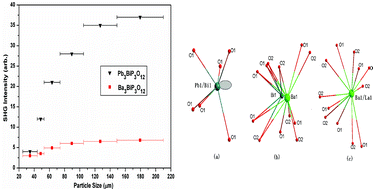A new eulytite-like orthophosphate Pb3Bi(PO4)3, was synthesized by the high temperature solution growth (HTSG) method and characterized by X-ray single crystal diffraction, powder diffraction and electron microscopy. It crystallizes in the acentric cubic space group (I![[4 with combining macron]](https://www.rsc.org/images/entities/char_0034_0304.gif) 3d). The pure-phase powders of Pb3Bi(PO4)3, Ba3La(PO4)3 and Ba3Bi(PO4)3 were also prepared by the high temperature solid reaction method. Second harmonic generation (SHG) measurements revealed that the optical response signals of Pb3Bi(PO4)3 and Ba3Bi(PO4)3 are about 3.0 and 0.5 times that of KH2PO4 (KDP), respectively, and both are phase-matchable. The SHG signal of Ba3La(PO4)3 is very weak. Our studies indicate that the enhancement of the nonlinear optical response is mainly due to the contribution from the irregular PbO6 and BiO6 octahedra due to the 6s2 lone electron-pair stereochemical activity in eulytite-like orthophosphates. Additionally, the calculated band structure and density of states also provide evidence that the charge transfers within irregular octahedral of Pb/BiO6 make a significant contribution to the nonlinear optical response.
3d). The pure-phase powders of Pb3Bi(PO4)3, Ba3La(PO4)3 and Ba3Bi(PO4)3 were also prepared by the high temperature solid reaction method. Second harmonic generation (SHG) measurements revealed that the optical response signals of Pb3Bi(PO4)3 and Ba3Bi(PO4)3 are about 3.0 and 0.5 times that of KH2PO4 (KDP), respectively, and both are phase-matchable. The SHG signal of Ba3La(PO4)3 is very weak. Our studies indicate that the enhancement of the nonlinear optical response is mainly due to the contribution from the irregular PbO6 and BiO6 octahedra due to the 6s2 lone electron-pair stereochemical activity in eulytite-like orthophosphates. Additionally, the calculated band structure and density of states also provide evidence that the charge transfers within irregular octahedral of Pb/BiO6 make a significant contribution to the nonlinear optical response.

You have access to this article
 Please wait while we load your content...
Something went wrong. Try again?
Please wait while we load your content...
Something went wrong. Try again?
![[4 with combining macron]](https://www.rsc.org/images/entities/char_0034_0304.gif) 3d). The pure-phase powders of Pb3Bi(PO4)3, Ba3La(PO4)3 and Ba3Bi(PO4)3 were also prepared by the high temperature solid reaction method. Second harmonic generation (SHG) measurements revealed that the optical response signals of Pb3Bi(PO4)3 and Ba3Bi(PO4)3 are about 3.0 and 0.5 times that of KH2PO4 (
3d). The pure-phase powders of Pb3Bi(PO4)3, Ba3La(PO4)3 and Ba3Bi(PO4)3 were also prepared by the high temperature solid reaction method. Second harmonic generation (SHG) measurements revealed that the optical response signals of Pb3Bi(PO4)3 and Ba3Bi(PO4)3 are about 3.0 and 0.5 times that of KH2PO4 (

 Please wait while we load your content...
Please wait while we load your content...